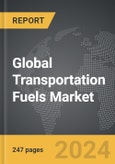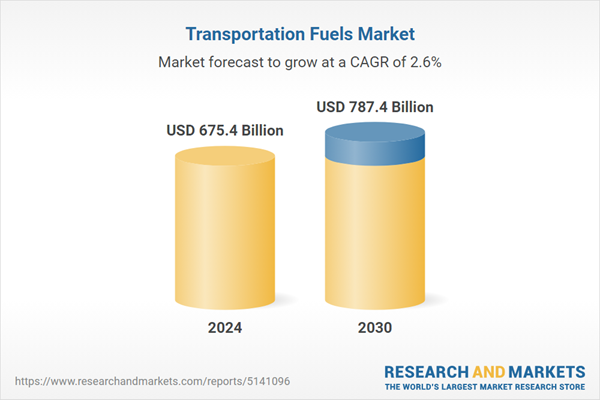Global Transportation Fuels Market - Key Trends & Drivers Summarized
How Is the Energy Transition Shaping the Transportation Fuels Market?
The global transportation fuels market is undergoing significant transformation due to the growing shift toward cleaner and more sustainable energy sources. Traditional fossil fuels, such as gasoline and diesel, are being gradually replaced by alternative fuels like electricity, biofuels, hydrogen, and natural gas as part of global efforts to reduce carbon emissions and combat climate change. The energy transition is being driven by increasing environmental awareness, stricter emissions regulations, and advancements in fuel technologies. Governments are actively promoting the use of renewable fuels through subsidies, tax incentives, and the implementation of clean energy mandates, which are encouraging the adoption of alternatives to conventional fuels.What Are the Key Innovations in Alternative Fuel Technologies?
Innovations in alternative fuel technologies are a major driving force in the transportation fuels market. Electric vehicles (EVs), powered by advanced battery technologies, are gaining popularity due to their zero-emission profiles and improved range and charging infrastructure. Similarly, hydrogen fuel cell vehicles are emerging as a promising option for long-haul transportation, offering faster refueling times and longer driving ranges compared to EVs. The development of biofuels, particularly ethanol and biodiesel, is also expanding, providing a cleaner alternative for traditional internal combustion engines. Natural gas-powered vehicles, which produce fewer emissions than diesel and gasoline, are becoming more common in heavy-duty transport sectors such as trucking and public transportation.How Is the Regulatory Landscape Driving the Adoption of Clean Fuels?
The regulatory landscape is a key factor driving the transition toward cleaner transportation fuels. Many countries have introduced stringent emissions regulations aimed at reducing greenhouse gas emissions from the transportation sector. In response, automotive manufacturers are increasingly developing vehicles compatible with alternative fuels, while energy companies are investing in cleaner fuel production and distribution infrastructure. Additionally, governments are offering financial incentives, such as tax breaks and rebates, to both consumers and companies that adopt green fuels. The push for net-zero carbon emissions targets is also leading to the development of policies that encourage the use of renewable fuels, further driving growth in this sector.The Growth in the Transportation Fuels Market Is Driven by Several Factors
The growth in the transportation fuels market is driven by several factors, including the global shift toward sustainable energy, technological advancements in alternative fuels, and regulatory mandates promoting cleaner fuel options. The rise of electric and hydrogen-powered vehicles is reshaping the fuel landscape, with innovations in battery and fuel cell technology making these options more viable for both consumer and commercial use. Additionally, the growing awareness of environmental concerns, coupled with government policies aimed at reducing emissions, is accelerating the adoption of biofuels and natural gas in transport. The ongoing investment in renewable energy infrastructure and the expansion of charging and refueling networks are also key factors propelling the growth of the transportation fuels market.Report Scope
The report analyzes the Transportation Fuels market, presented in terms of market value (US$ Thousand). The analysis covers the key segments and geographic regions outlined below.- Segments: Segment (Gasoline, Diesel, Aviation Turbine Fuel (ATF), Natural Gas, Other Segments).
- Geographic Regions/Countries:World; United States; Canada; Japan; China; Europe (France; Germany; Italy; United Kingdom; Spain; Russia; and Rest of Europe); Asia-Pacific (Australia; India; South Korea; and Rest of Asia-Pacific); Latin America (Argentina; Brazil; Mexico; and Rest of Latin America); Middle East (Iran; Israel; Saudi Arabia; United Arab Emirates; and Rest of Middle East); and Africa.
Key Insights:
- Market Growth: Understand the significant growth trajectory of the Gasoline segment, which is expected to reach US$498.7 Billion by 2030 with a CAGR of a 2.5%. The Diesel segment is also set to grow at 2.6% CAGR over the analysis period.
- Regional Analysis: Gain insights into the U.S. market, valued at $176.5 Billion in 2024, and China, forecasted to grow at an impressive 4.6% CAGR to reach $164.5 Billion by 2030. Discover growth trends in other key regions, including Japan, Canada, Germany, and the Asia-Pacific.
Why You Should Buy This Report:
- Detailed Market Analysis: Access a thorough analysis of the Global Transportation Fuels Market, covering all major geographic regions and market segments.
- Competitive Insights: Get an overview of the competitive landscape, including the market presence of major players across different geographies.
- Future Trends and Drivers: Understand the key trends and drivers shaping the future of the Global Transportation Fuels Market.
- Actionable Insights: Benefit from actionable insights that can help you identify new revenue opportunities and make strategic business decisions.
Key Questions Answered:
- How is the Global Transportation Fuels Market expected to evolve by 2030?
- What are the main drivers and restraints affecting the market?
- Which market segments will grow the most over the forecast period?
- How will market shares for different regions and segments change by 2030?
- Who are the leading players in the market, and what are their prospects?
Report Features:
- Comprehensive Market Data: Independent analysis of annual sales and market forecasts in US$ Million from 2024 to 2030.
- In-Depth Regional Analysis: Detailed insights into key markets, including the U.S., China, Japan, Canada, Europe, Asia-Pacific, Latin America, Middle East, and Africa.
- Company Profiles: Coverage of players such as BP PLC, Chevron Corporation, China Petroleum & Chemical Corporation (SINOPEC), Exxon Mobil Corporation, Nayara Energy Limited and more.
- Complimentary Updates: Receive free report updates for one year to keep you informed of the latest market developments.
Some of the 48 companies featured in this Transportation Fuels market report include:
- BP PLC
- Chevron Corporation
- China Petroleum & Chemical Corporation (SINOPEC)
- Exxon Mobil Corporation
- Nayara Energy Limited
- Petrobras
- PetroChina Co., Ltd.
- Phillips 66 Company
- Royal Dutch Shell PLC
- Saudi Arabian Oil Co.
- SINOPEC Group
- Total SA
This edition integrates the latest global trade and economic shifts into comprehensive market analysis. Key updates include:
- Tariff and Trade Impact: Insights into global tariff negotiations across 180+ countries, with analysis of supply chain turbulence, sourcing disruptions, and geographic realignment. Special focus on 2025 as a pivotal year for trade tensions, including updated perspectives on the Trump-era tariffs.
- Adjusted Forecasts and Analytics: Revised global and regional market forecasts through 2030, incorporating tariff effects, economic uncertainty, and structural changes in globalization. Includes historical analysis from 2015 to 2023.
- Strategic Market Dynamics: Evaluation of revised market prospects, regional outlooks, and key economic indicators such as population and urbanization trends.
- Innovation & Technology Trends: Latest developments in product and process innovation, emerging technologies, and key industry drivers shaping the competitive landscape.
- Competitive Intelligence: Updated global market share estimates for 2025, competitive positioning of major players (Strong/Active/Niche/Trivial), and refined focus on leading global brands and core players.
- Expert Insight & Commentary: Strategic analysis from economists, trade experts, and domain specialists to contextualize market shifts and identify emerging opportunities.
Table of Contents
Companies Mentioned (Partial List)
A selection of companies mentioned in this report includes, but is not limited to:
- BP PLC
- Chevron Corporation
- China Petroleum & Chemical Corporation (SINOPEC)
- Exxon Mobil Corporation
- Nayara Energy Limited
- Petrobras
- PetroChina Co., Ltd.
- Phillips 66 Company
- Royal Dutch Shell PLC
- Saudi Arabian Oil Co.
- SINOPEC Group
- Total SA
Table Information
| Report Attribute | Details |
|---|---|
| No. of Pages | 247 |
| Published | December 2025 |
| Forecast Period | 2024 - 2030 |
| Estimated Market Value ( USD | $ 675.4 Billion |
| Forecasted Market Value ( USD | $ 787.4 Billion |
| Compound Annual Growth Rate | 2.6% |
| Regions Covered | Global |









